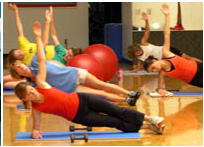 Tabatas are changing the way we think of working out and redefining the fitness world. When it comes to weight loss and improving performance, nothing works as efficiently, effectively and fast as tabata training. What's the drawback? For those of you who have experienced this type of training firsthand, you know the problem is tabatas are downright HARD. Not everyone can safely perform tabata training but for those that can push themselves to their limits, this type of workout can provide quick results.
Tabatas are changing the way we think of working out and redefining the fitness world. When it comes to weight loss and improving performance, nothing works as efficiently, effectively and fast as tabata training. What's the drawback? For those of you who have experienced this type of training firsthand, you know the problem is tabatas are downright HARD. Not everyone can safely perform tabata training but for those that can push themselves to their limits, this type of workout can provide quick results.Tabata training is named after Dr. Izumi Tabata, who led a team of researchers at the National Institute of Fitness and Sport in Tokyo. Tabata compared the effects of moderate intensity endurance training and high intensity intermittent training (tabatas) on VO2 max (the body's maximum ability to uptake and transport oxygen to working muscles) and anaerobic capacity (the ability to produce maximum power in a short amount of time). They found the moderate intensity training group improved their VO2 max score by 10% but had no changes in anaerobic capacity. Meanwhile, the tabata interval training group improved their VO2 max by 14% and anaerobic capacity by 28%!. In addition, the tabata trained participants burned approximately 9x more fat per calorie expended during exercise than the moderate intensity group due to EPOC (excess post oxygen consumption). The bottom line, tabata training is one of the most effective tools for weight loss and improved performance.
A tabata consists of a 2o second sprint followed by 10 seconds of rest repeated for 8 cycles for a total of 4 minutes. Normally, the same exercise is repeated the entire cycle. In order for tabatas to be effective, the sprint interval must be performed at a person's maximum intensity. The small amount of rest between each hard interval makes tabatas very intense. Therefore, they are not for people just starting an exercise program or for people with cardiovascular disease risk factors. Longer intervals with longer rest periods are more appropriate for these individuals.
In order for a tabata exercise to be effective, it needs to be a powerful, simple exercise that incorporate many muscle groups. Examples include running or cycling sprints, burpees, jump roping, kettlebell swings, stair running and plyometrics. Exercises such as bicep curls or leg presses won't cut it. Tabata training should only be performed 2-3x per week on non-consecutive days. Your muscles need a few days to recover and replenish after this type of high intensity training.
You can do your own quick and efficient tabata workout at home by choosing 3-5 of the exercises above. You can either do the entire 4-minute tabata using the same exercise or you can mix up 2-4 different exercises. Just remember, your rest interval is only 10 seconds so your exercise transitions need to be fast. Allow yourself at least 1.5-2.5 minutes rest between tabatas. Enjoy and good luck (as my bootcampers know, you'll need it)!



